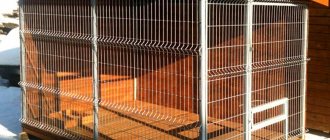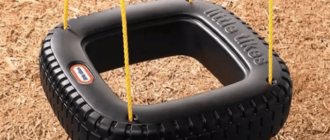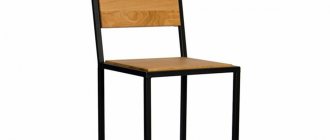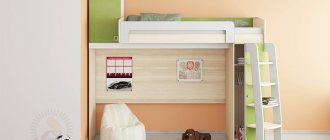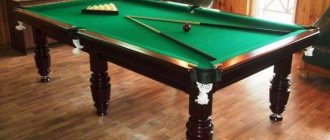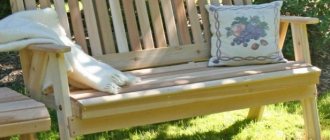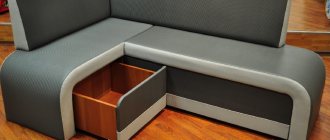If you have a country house and you want your beloved pet to have no less comfortable living conditions in the fresh air than you have, it’s time to think about how to build an enclosure for your dog. After all, it’s no secret that four-legged animals kept in enclosures are susceptible to various diseases to a much lesser extent than those who live in the house with their owners. Today, in specialized stores, you can easily purchase a ready-made enclosure for your dog, however, as often happens, standard designs are not always to the taste of your pets. By building an enclosure yourself, you can take into account all the preferences of your four-legged friend, choose the appropriate size for him, and also create a beautiful design that will fit perfectly into the overall landscape of your site.
General requirements: what should the enclosure be like?
Having decided to purchase or build an enclosure yourself, you should take into account certain requirements for this type of structure. The comfort and safety of the pet depends on them. Let's look at the general rules:
- An area for permanent keeping of dogs should consist of three main parts: a booth, a useful space, and an area for eating.
- It is advisable to locate the enclosure on a dry, flat hill, taking into account the presence of shade.
- On the north side, the object must be fenced with a wall.
- The dimensions of the building are selected according to the size of the dog.
- The floor covering should not contain defects, cracks, or gaps that could cause injury.
- To simplify cleaning, the floor is equipped with a slight slope towards the front wall.
- When choosing the number of open surfaces, from one to three, preference should be given to an option that will allow the dog to view the entire territory, then he will not feel discriminated against or locked in.
When making walls, you should not use chain-link mesh, which quickly stretches and breaks, as well as powder-coated, galvanized pipes. Metal and other possible models cannot be placed in a horizontal position.
Create a drawing
Before starting work, you need to create a plan for further action. In this case, drawings of an enclosure for dogs will be the optimal solution. They will allow you to foresee any nuances of the work. It needs to take into account the presence of a foundation. This is not always necessary if the dog will not live there permanently.
Zones need to be demarcated. Mark where the wooden platform will be located. The animal itself will live there and the booth will be located there. The place where the dog will eat can be laid out using tiles or wooden boards. Dog walking is a special place, decorated with grass or soil.
The presence of a separate booth needs to be thought out in advance. In some cases you can do without it. If the enclosure is completely open, then a booth is required. If the enclosure is built with blocks that can protect from wind and frost, then the booth is not built.
Requirements for materials for construction
The enclosure should be equipped from proven materials. Wood and metal are suitable for these purposes. You should not place additional decorations on the grill, which could damage your pet’s paws. Fasteners should be kept to a minimum. First of all, it is recommended to take care of the base. It is selected depending on the service life of the structure. For seasonal buildings at the dacha, it is enough to fill a cushion of expanded clay or sand. For a stationary object intended to be used for several years, a strip or column foundation is suitable.
The floor inside the enclosure can be sandy or earthen, no different from the surrounding soil. Open ground is more acceptable for a dog to cope with its natural needs. Wooden covering is also used. If insulation is placed under the boards, the structure can be used in winter. When planning a building for the permanent residence of an animal, you can combine an open area with wooden flooring.
If there is a concrete base, the walls can be built from brick, cellular concrete, or use a metal frame covered with wood, usually coniferous. The enclosure must have at least one open side, fenced with a welded, forged lattice. The gate is made of a metal frame and iron rods.
It is better to use slate and metal tiles for roofing; they retain heat well. Some people use corrugated sheeting, but it is not suitable for roofing; during hot periods it overheats, and in winter it emits cold. When choosing any material, a visor should be provided.
The booth is erected in two ways: as a separate object, as a compartment of a common object, fenced off from the walking area by a partition. The optimal building material for constructing the box will be natural wood. Timber is used for the frame, and the walls and roof can be made from various wooden slabs.
Construction of the foundation
The first and most critical stage of the work is to prepare the foundation.
For the convenience of the owner, you can choose a solid concrete screed, strip foundation (without recess) and stone flooring.
Instructions on how to make the base of an enclosure for a dog with your own hands:
- All construction debris and large stones should be removed from the prepared site.
- The next step is to remove the surface layer of soil.
- The bottom and walls of the resulting pit are leveled.
- Sand and gravel are poured into the entire depth of the prepared pit (approximately 0.2-0.3 meters) in a 1:1 ratio.
- Brick or tile borders are installed along the periphery of the limited area.
The next task of the master is to pave the area with stone or brick. The seams between adjacent elements are covered with a mixture of dry cement and sand. As an alternative, you can make a solid concrete screed.
Classification of enclosures by type of structure
To decide which pet playground to install in your dacha or on your own property, you should consider possible design options. Their sizes depend on the characteristics of the dog, the appearance on the purpose, and the personal preferences of the owner. Based on the type of structure, all buildings can be divided into three main groups:
- Temporary. The structures are characterized by the presence of four open walls. They are a platform fenced on all sides with metal bars. For the dog’s convenience, a booth or flooring is installed inside. Models are often not covered with roofing material.
- Closed. This is a full-fledged enclosure designed for permanent residence of a four-legged friend. A booth is installed inside and insulation is provided. The structure has two or three solid walls, and the surface is fenced with a metal grill.
- Capital. The structure is divided into several zones. It has a separate room, fenced on four sides by walls, in which there is a booth, a special area for walking and feeding, surrounded by bars. During the cold season, the feeding area is moved to a protected area.
Creating a roof
The roof may not be over the entire enclosure. Although some are trying to arrange it around the entire perimeter. This will shelter the animal from any harsh weather conditions.
The choice of roofing material can be anything. It is better to use a wooden enclosure partially. This material creates unique thermal insulation. The soft material allows for maximum noise insulation.
This action is necessary, because dogs can often bark and interfere with the normal activities of their owners. The door to the enclosure should open inward. It is better to make bolts and locks, both from the inside and outside.
Choosing the optimal location for construction
An important issue when planning a structure is choosing a suitable location for it. The mental state of the pet, its behavior, a comfortable overview of what is happening, the peace of the owner himself, and the emergence of conflict situations with neighbors depend on this. When placing the structure on the site, the following points should be considered:
- The dog must have a full view of the yard, including the entrance.
- You cannot build a site near a garage, latrines, compost pit, sewerage system, or other objects with unpleasant and pungent odors that can lead to the pet losing its sense of smell.
- It is recommended not to install the structure right next to the house, but it is also not worth moving it to a great distance, otherwise the dog will feel abandoned.
- Free access to the structure should be provided.
- The optimal place for an enclosure will be a hill located in the front part of the yard. In the lowlands, the building will be constantly flooded after rains.
- It is advisable that a tree grow near the object, but one that does not produce large fruits; it will protect the pet from the sun's rays.
- Close proximity to a fence located near a street or roadway will lead to irritation of the four-legged friend and unreasonable barking.
Where to place it correctly
The correct place is considered to be the one that is typical of the recommendations:
- Preference is a flat, dry area, no drafts or gusts of wind.
- The animal has a maximum view of 120° in both directions.
- The location is not close to the entrance and fence.
- Complete isolation from the owner is eliminated and loneliness is not experienced.
- Away from the windows of the house. So that the smells do not reach the hut.
Calculation of dimensions and design features
The size of the structure is determined depending on the number of living pets, the height of their withers, and gender. To keep two dogs or a female with puppies, the enclosure will have to be increased by 1.5 times. The width of the structure should be one and a half times the length of the dog, but not less than 150 cm. The height can also be determined experimentally. To do this, the dog must be raised on its hind legs, measure the distance from the floor to the end of the outstretched front legs, add 20-50 cm to the resulting measurements. The length is determined depending on the area and width of the building.
A low ceiling will put pressure on the animal’s psyche, causing the dog to become more aggressive and try to leave its home.
The table below shows area standards for different sized pets.
| Type of dogs | Withers height, cm | Optimal enclosure area, m2 | Booth dimensions, cm | Manhole dimensions, cm | |||
| width | depth | height | width | height | |||
| Little ones | < 50 | < 6 | 70 | 55 | 60 | 30 | 40 |
| Average | 50 – 60 | 6-10 | 115 | 75 | 80 | 35 | 50 |
| Large | > 60 | >10 | 135 | 100 | 95 | 40 | 60 |
For small breed dogs
Small breed dogs, for example, pug, dachshund, Basenji, Klee Kai, etc., are classified as pets that live in the house. If they stay outside for a long time, they can get sick, or even worse, die. The enclosure for these pets is used exclusively for preventive purposes and for the entertainment of their four-legged companion. The booth in the structure can be replaced with flooring, where the dog could rest. When arranging the site, the following points are taken into account:
- The building area does not exceed 6 m2. If it is larger, the animal will begin to experience discomfort and fear.
- The height of the walls is determined empirically, but in most cases 1.5 m is sufficient.
- The optimal size of the structure, determined by professional dog handlers, is 2x3 m.
- You can do without a roof and provide partial coverage. Small dogs should not be exposed to rain or bright sunshine.
- A small mattress is suitable as a bed.
- The fence is made of wood and metal and has 2 or 3 closed walls.
- The floor is only wooden.
For medium breed dogs
Medium breeds include the White Swiss Shepherd, Bull Terrier, English Bulldog, and others. They are free to live outside the home. For their comfortable living, it is enough to equip a permanent site. It must have a booth, an area for eating, and useful space. The aviary must meet certain requirements:
- The total area is from 6 to 10 m2. With lower values, the dog will feel cramped.
- The height of the partitions is within 2-2.5 m.
- The optimal size of the pen is 3x3 m; other models are possible, depending on the length of the dog.
- If the building is planned to be used all year round, then the floor covering is made of wood and an additional layer of insulation is provided.
- Slate is used as roofing material.
- Brickwork and natural wood are used for the walls, one of them is left open.
For large breed dogs
Large dogs include Great Dane, Caucasian Shepherd Dog, English Mastiff, Bully Cutta, and other breeds. Large dogs simply cannot live at home, they do not like confined spaces, they need freedom. In a cramped room, a pet develops anger and aggression, which can lead to sad consequences both for the owner himself and for guests or loved ones. When setting up an enclosure, it is worth remembering:
- The area of the pen must exceed 10 m2. Large dogs love space.
- The height of the walls varies from 2.5 to 3.5 meters.
- The size is calculated individually, it can be 3x4 m, 4x4 m, or more. When 2 individuals live, the area increases by 1.5 times.
- The remaining parameters are similar to those discussed above. The enclosure should have a large warm booth, an insulated wooden floor, laid on a concrete base.
- The iron bars must be reinforced so that a large pet cannot damage them.
- At least one north side must be closed.
Features for puppies
Usually puppies are raised by a bitch. For these purposes, an enlarged capital enclosure is provided, divided into several functional zones. It will be equipped with a separate room, fenced on all sides. Essentially, a simple pen made from standard materials is used. In it, kids adapt to their future life.
For small breeds of dogs, small temporary structures are specially purchased and made with your own hands, which allow you to protect inquisitive pets from moving around the apartment or house. They are needed for the initial training of a dog. For a comfortable stay for the puppy, they will be equipped with:
- a place to sleep;
- eating area;
- a tray for dealing with natural needs;
- various toys that contribute to the development of the baby.
Kennel
You don't have to build a kennel that is too big. Its area should be exactly such that the dog can turn freely, and its height should be approximately one and a half times the height of the dog at the withers.
The doghouse needs to be warm, so they make it wooden. Ideally, make the floor and walls in 2 layers (for example, board and plywood) and insert thermal insulation material between them.
The size of the kennel should match the size of the dog
The dog spends most of its time in the enclosure. Therefore, it is extremely important to make it spacious, comfortable and warm.
We build an aviary with our own hands
To build a high-quality and comfortable structure for your pet, you need to choose a suitable place for it, take measurements of the pet to determine the optimal size of the pen. Then a project is drawn up, which indicates the functional areas. Then they move on to preparing tools and purchasing missing materials.
Having completed these steps, they begin to erect a building on their own site. The structure is quite simple and does not have a complex design. Anyone can build it with their own hands, even those who do not have construction skills. The process occurs in several stages:
- Preparing the base.
- Pouring the foundation.
- Metal frame equipment.
- Laying flooring.
- Walling.
- Roof installation.
Mistakes to Avoid
When building an enclosure yourself, mistakes are often made that negatively affect the pet. To prevent them, let's consider common inaccuracies and shortcomings:
- The location for construction has been incorrectly determined. In an open area unprotected by tree crowns, the structure will be ventilated and in direct sunlight. Water will accumulate in the recess.
- The building is fenced on all sides by other functional buildings that block the view. The dog loves to observe everything and be in sight.
- Low ceiling. The dog will become aggressive and will not be able to get used to such housing.
- Small or oversized, incorrect aspect ratio.
- The use of combined materials in the construction of walls, for example, metal and plastic, wood.
- Fastening wooden frame elements with nails.
- Using a chain-link mesh, which the dog can damage and injure himself on the sharp wire.
Materials and tools
Before starting construction, you should prepare the tools required for work, namely:
- bayonet and scoop shovels, buckets;
- concrete mixer, old cast iron bath for mixing mortar;
- hammer, screwdriver, saw, jigsaw;
- welding machine;
- measuring instruments, string, level.
Materials you will need:
- cement, crushed stone, sand, water;
- metal corner, profile, pipes;
- wooden beam, board;
- slate or tiles;
- insulation (expanded polystyrene, mineral wool);
- paint, varnish, antiseptics for wood processing;
- bolts, screws, nails.
Project drawing with zoning
You can draw up a construction plan with your own hands, use a ready-made drawing found in specialized literature, downloaded from the Internet. When planning independently, the diagram must display the following points:
Zoning:
- Winter road, if provided. It is a room surrounded on all sides by blank walls.
- A place to sleep. The area in which the booth will be located.
- Walking area. Area for permanent residence of a pet.
- A place to eat.
- Entrance door opening area.
Main dimensions:
- total area of the building;
- height of partitions;
- length and width of the structure.
Components:
- type of foundation (ribbon columnar);
- type of roof (single-pitched, double-pitched);
- building frame;
- wall construction, floor lathing, canopy.
Choosing a base or foundation
For temporary, seasonal construction, it is enough to prepare the site and fill it with gravel or sand. When building a massive, durable pen, you will need a good foundation. The structure is not characterized by great weight, so for its construction a columnar or strip foundation or a concrete screed made at a slight slope is sufficient. Let's consider the step-by-step process of filling the most common base in the form of a tape:
- The selected site is cleared of debris and dirt.
- A trench is dug 45 -50 cm deep and 30 - 40 cm wide.
- The soil is compacted, a cushion (15 cm layer of sand) is poured onto the bottom and also compacted.
- The formwork is installed, for this you can use any available material, put it together from boards, wooden sheets, pallets.
- A metal frame is knitted inside the formwork.
- The solution is mixed in a concrete mixer or an old bathtub.
- The foundation is poured and the top is covered with polyethylene for several days.
Flooring
The wooden floor is laid on joists. To use the structure throughout the year, a layer of insulation should be provided. The wood is treated with special water-repellent compounds and antiseptics. The step-by-step installation looks like this:
- The height of the floor covering is determined.
- A string is stretched along the perimeter of the future structure, which serves as beacons.
- A wooden sheathing is mounted from timber and boards, fixed to the base.
- In the voids between the joists, a layer of insulation made of expanded polystyrene or mineral wool is laid.
- Using self-tapping screws, boards are attached to the sheathing.
- At the final stage, the floor covering is painted and varnished.
Wall installation
To protect the dog from blowing, the structure is equipped with three solid walls, and one is made of a metal lattice, the bars of which are located exclusively vertically. Some owners make only two closed walls to increase illumination and visibility for the pet, so that they do not feel constrained.
Brick partitions can be erected on a strip foundation. This is a good material; it keeps you warm in cold weather. To do this, lay out the first row of three blank walls on the base. Half a brick is enough thickness; for large dogs it can be made into one. The second and subsequent layers are laid in a checkerboard pattern. In place of the open wall, a metal partition with a door is installed.
If wood is chosen as the main material, then first a frame made of metal or wood is built. Then markings are made on it, holes for the bolts are drilled. It is better to do without nails, which a pet can tear out by loosening the nailed board. After the wall is erected, the wood is coated with varnish using special compounds.
Roof construction technology
The enclosure is equipped with a pitched or gable roof. In the first option, one of the walls is made slightly higher than the other to maintain the required slope. The process for installing a single slope canopy is as follows:
- On two parallel sides, where the angle of inclination will be, install a Mauerlat or wooden strapping.
- Rafters with a cutout for the Mauerlat are laid on top of them along the entire length, and fixed to the beam using metal corners. The sides can be strengthened with a tie beam. The distance between the rafters should be 0.7-1 m when using tiles, 1.5-3 m for slate.
- A sheathing is installed on top of the rafter system.
- At the final stage, the roofing material is attached.
Dog kennel and feeding area
The construction of a booth should be approached with all responsibility. It is a pet's house in which he rests and hides. When building yourself, you first need to pay attention to the following points:
- The size of the object must correspond to the parameters of the dog, the internal space should be enough for the dog to be comfortable, but an overly large booth will be cold.
- Coniferous wood is used in construction.
- For cold winters, it is worthwhile to provide an insulated structure.
- The roof should be made flat, as it is a kind of pedestal for the pet from which he watches what is happening. It is recommended to make it removable, so that if the animal is sick, it can be easily examined and, if necessary, removed.
When constructing a feeder, it is preferable to place it near the front door, providing a special window for it. This option is good because sometimes you have to leave your home and entrust the care of the animal to a friend. In this case, a stranger will not put himself in danger by trying to feed someone else's dog.
Making a booth
The Boston Terrier and French Bulldog will be in comfort when the enclosure is supplemented with a good-quality booth. The first rule is the parameters, they are significant and are chosen according to the physique of the LEONBERGER or Rottweiler. The Caucasian Shepherd will not go inside until it becomes comfortable and spacious for sleeping, resting, staying until sunset, the heat subsides, and coolness sets in.
Based on this, they draw a sketch, detail the drawings, and calculate the materials:
- The pet is measured at the withers with the tips of the paws.
- The second parameter, from the nose to the tailbone, will give the size in the lying position.
- Tolerances are made + 15 cm.
3 sizes will create an ideal neat outline: Siberian Husky and Samoyed.
About enclosures from the store: advantages and disadvantages
By looking at advertisements online or going shopping, you can find many offers from different firms and companies for the sale of finished structures. It is also proposed to manufacture any structure to order according to the provided drawings, the requirements, from any materials. The advantages of such objects include:
- The construction of structures is carried out by specialists, which allows you to avoid many mistakes made when doing it yourself.
- The manufacturer provides a warranty period for its product.
- A wide range of. You can choose a beautiful product to suit every taste.
- Mobility. Prefabricated structures can be easily assembled and dismantled, and stored in a utility room.
Among the disadvantages it is worth highlighting:
- High cost. A building built with your own hands will cost much less.
- Uniqueness. Products are mass produced.
- Quality of materials. When carrying out work, the owner himself selects building materials.
Photo
Elite enclosure designs: notice how beautiful they are!
We especially like the forged bars on the enclosures:
Modular:
With booth:
An original solution to build an enclosure made of bricks:
For a large dog, be sure to make a pen with a walk:
For two or three dogs:
We will install a fence or barrier
The barrier holding the dog back is the important part. It is necessary to consider how high the barrier should be to keep the dog.
A chain link fence can be an easy option, but most medium to large dogs can jump a regular fence. 180 centimeters or more is a good height for a fence. Some dogs may require a higher fence.
When is a special room needed?
An aviary will be required in the following cases:
- a baby appeared in the family;
- the old booth has become too small for the pet;
- the dog “has” its own offspring;
- On a suburban property, the owners have some livestock that needs to be protected from the dog.
A special building for the guard of a suburban area will solve all of the above problems.
How to care?
In order for the enclosure to last longer, it should not be ignored. You need to regularly:
- carry out dry and wet cleaning;
- paint;
- If possible, antisepticize wooden parts.
Arrangement
If you decide to build a structure yourself, listen to the advice of professional breeders:
- in order to save money and space, do not reduce the established size standards;
- do not make the enclosure too large - in winter it is difficult to maintain the required temperature;
- carefully consider and follow the rules for making the walls, roof and floor of the enclosure.
Let us consider in more detail how to correctly manufacture individual structural elements.
Floor
We had already decided earlier that we would make the floor from wood. There are no special subtleties here; the shield is made of planed dry boards 35 mm thick.
The wood should be treated with an antiseptic and space under the floor should be left for ventilation.
Door
Dog handlers recommend that the door opens into the enclosure. This will protect you from being hit if the dog might jump. An exception is possible only if the size of the building does not allow such an approach.
Also use the advice - do not make the door on the side of a solid wall. The dog must see the person entering in advance. Be sure to provide, in addition to a reliable external latch, the ability to close the door behind you from the inside.
Walls
A dog is an inquisitive animal, so it needs to be given the opportunity to observe the surrounding area. One or two sides of the structure must be decorated with mesh or gratings.
Important! “Mesh” walls should not have sharp elements so that the dog does not get hurt. It is better to decorate blank walls with boards or lay them out with bricks.
Concrete
If you don't have experience pouring concrete, it's best to hire a professional to do the task. However, if we want to do it ourselves, we look for videos on the Internet.
Advantages:
- It's low maintenance
- Concrete floors last a long time
Flaws:
Not as easy on dogs' joints and paws as other flooring options.
- It is expensive
- Dogs don't like to "mind their own business" on concrete.
The disadvantages of concrete are that dogs do not like to go to the toilet on concrete as much as, for example, on grass. It is also harder on the paws and joints.
